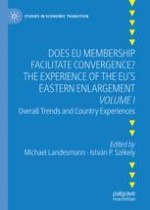2021 | OriginalPaper | Buchkapitel
2. Convergence of the EU Member States in Central-Eastern and South Eastern Europe (EU11): A Framework for Convergence Inside a Close Regional Cooperation
verfasst von : István P. Székely, Robert Kuenzel
Erschienen in: Does EU Membership Facilitate Convergence? The Experience of the EU's Eastern Enlargement - Volume I
Aktivieren Sie unsere intelligente Suche, um passende Fachinhalte oder Patente zu finden.
Wählen Sie Textabschnitte aus um mit Künstlicher Intelligenz passenden Patente zu finden. powered by
Markieren Sie Textabschnitte, um KI-gestützt weitere passende Inhalte zu finden. powered by
